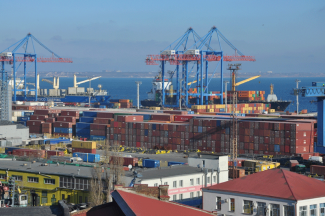Russia hits transports to Odesa. Day 964 of the war

![]()
Russian forces continued to operate across a broad frontline in the southern part of the Donetsk Oblast. They are pressing towards Bohoyavlenka, which is supplying Vuhledar and through which the road to Kurakhove leads from the south. They captured Zolota Nyva, the last village south-east of the Velyka Novosilka junction. They also launched a strike south-west of this town (within the Zaporizhzhia Oblast), where they retook a town recaptured by the Ukrainians in the summer 2023 offensive, Levadne. This indicates an intention to broadly outflank Velyka Novosilka, which is directly shielded from the south by several lines of fortifications.
In Toretsk Russian troops attacking this city from the east and from the south have merged. From the centre the Ukrainians are being pushed to the north-western part, but Russian progress is slow, with battles for individual quarters continuing. According to the Ukrainian administration, 40–50% of Toretsk remains under Ukrainian control and there are 1,150 people who do not want to leave the destroyed city (in 2022 it had a population of 31,000). Russian forces have deepened their flanking of Selydove from the south, where they aim to cut off its last connection to Pokrovsk (near the village of Vyshneve). According to some sources, on the other hand, the Ukrainians succeeded in re-establishing control over its north-eastern outskirts. After seizing the village of Ostrivske, the Russians advanced to the eastern outskirts of Kurakhove. They also made slight advances in the other directions with the exception of the area north of Kharkiv.
In the Kursk Oblast, Russian troops continued to eliminate the western part of the breach established by the enemy in August this year. The Russians took control of the northern section of the Korenevo-Sudzha road and, according to some sources, cut off the Ukrainian units defending it to the west (in the area of the village of Tolstoy Lug). They also pushed them out of the Glushkovo area (west of the main combat area), where they had tried to come out to the rear of the counter-attacking Russian troops in September. The keystone of the Ukrainian defence is Sudzha, the holding of which has become decisive for the preservation of the Ukrainian presence in the Kursk Oblast. In the vicinity of this town, the Russians have so far failed to make significant advances.
![]()
Russia continued the missile attacks on Odesa’s port infrastructure. As a result, three more cargo ships were damaged. On 9 October, missiles hit the Panama-flagged container ship Shui Spirit. Six people were killed and eight injured at the time (the death toll rose to nine in the following days). On 14 October, the container ship Optima (Antigua and Barbuda) and the cargo ship NS Moon (Belize) were hit. One person was killed and eight injured. In addition, on 9, 10 (twice), 12 and 13 October, Russia struck other facilities in the region. Information about another attack on Odesa emerged on the morning of 15 October. A total of five cargo ships have been damaged by Russian missiles since the beginning of the month, and these were not vessels used to transport agricultural products. The Russians treat them as carrying war material.
Russia intensified its attacks on Mykolaiv – hitting the city’s critical infrastructure on 10 October (twice) and five days later. In the second of the attacks, it is thought it used as many as seven missiles. These caused the death of one person and injured 23. On 9 and 10 October, the invaders’ drones damaged infrastructure in Mykolaiv Oblast (including a power substation). Energy facilities (mainly substations) were also damaged in Kherson (10 and 12 October), Khmelnytskyi and Poltava (10 October) and Kharkiv and Sumy (11 October) oblasts. Rocket attacks on industrial infrastructure occurred in Kremenchuk in the Poltava Oblast (on the evening of 8 October) and in Zaporizhzhia (12 October). On 9 October, a double missile strike destroyed elements of a Patriot system battery in the Dnipro raion. According to Ukrainian data, Russia used a total of 52 missiles from the evening of 8 October until the morning of 15 October, of which Ukraine claimed to have shot down just one, as well as 263 Shahed/Geran drones. 158 drones were said to have been shot down and 87 were said to have been locationally lost, possibly due to the impact of Ukrainian electronic warfare systems.
![]()
On 14 October, Ukrainian police reported receiving false reports of explosives being planted in buildings occupied by state and local government authorities and the editorial offices of news websites. Similar warnings were received at most diplomatic missions. According to the police, there are many indications that the false bomb threats are part of a psychological operation by Russia to increase the sense of threat in society (most of the messages came from Russian IP addresses).
![]()
On 9 October, Ukrainian drones hit the 67th Arsenal of the Main Rocket and Artillery Board of the Russian Ministry of Defence. Located near Karachev in the Bryansk Oblast, the facility was said to have been attacked by at least 24 drones. No major damage was confirmed as a result of the strike, but nevertheless, for the third time – after two attacks in September – the Russians failed to provide adequate protection to one of their most important ammunition storage sites. On the same day, Ukrainian drones also struck the village of Oktyabrsky in Krasnodar Krai, resulting in damage to one of the storage buildings. According to the Ukrainian General Staff, Shahed drones were stored in the town. In contrast, neither the strike on Russian territory on 10 October – the largest since the beginning of the month (the Russians claimed to have destroyed 92 drones) – nor the attack carried out two days later were successful.
![]()
On 11 October, during President Volodymyr Zelensky’s visit to Germany, Chancellor Olaf Scholz announced a new ‘large’ military support package prepared together with Belgium, Denmark and Norway. It is worth €1.4 billion and includes the previously announced further IRIS-T air defence systems, Skynex anti-aircraft artillery systems, Gepard self-propelled anti-aircraft guns, self-propelled howitzers, armoured vehicles, drones, radars and ammunition. Two days earlier, General Christian Freuding, who is responsible for supporting Ukraine at the German Ministry of Defence, confirmed the delivery of IRIS-T SLM and IRIS-T SLS systems. Two more systems of the aforementioned types remain to be handed over by the end of the year. They will most likely be part of the package Scholz spoke of.
On 9 October, President Emmanuel Macron, accompanied by the Defence Ministers of France Sébastien Lecornu and Ukraine Rustem Umerov, visited Ukrainian soldiers being trained by France. On the occasion, information was revealed about the 155th All-Military Brigade of the Ukrainian Armed Forces, being formed under the patronage of Paris and named after Anne of Kyiv (daughter of the Grand Prince of Rus Yaroslav the Wise and Queen of France). France is responsible for training 2,300 servicemen (the brigade is expected to have 4,500 in total) and equipping the unit (including 128 VAB wheeled armoured personnel carriers, 18 AMX-10RC armoured reconnaissance vehicles and 18 CAESAR self-propelled howitzer). The Ukrainian soldiers are practising in France with the armament, with which they are expected to return home later.
The meeting of the contact group of countries supporting Ukraine militarily in the Ramstein format with heads of state scheduled for 12 October did not take place due to the cancellation of the visit by the US president. Although Joe Biden is scheduled to fly to Germany on 17–18 October, a new date for the group’s meeting has not yet been set.
On 8 October, the UK imposed sanctions on the Russian Federation’s Radiological, Chemical and Biological Defence Forces, their commander Igor Kirillov and two defence ministry laboratories involved in research on chemical warfare agents. Restrictions include the freezing of assets (of individuals and legal entities) and a ban on obtaining funding. The immediate reason for their introduction was the use of the asphyxiating agent chloropicrin by Russian troops.
On 9 October, Ukraine and Croatia concluded an agreement on long-term support and cooperation. According to the document, the total assistance provided by Zagreb to Kyiv since February 2022 has amounted to approximately €300 million (including 11 defence packages). Croatia has confirmed its readiness for cooperation between defence industries and in the areas of cyber-security and intelligence sharing, as well as to continue to support Ukraine’s de-mining efforts. It has already allocated more than €10 million for this purpose. Kyiv has so far signed 27 bilateral agreements of this type.
![]()
On 9 October, the press service of the arms conglomerate Ukroboronprom announced that its revenues from January to September this year amounted to 83.1 billion hryvnias (more than $2 billion) and a net profit of 8.74 billion hryvnias (about $210 million). The good financial health is due to growth in the production of drones, ammunition and precision weapons. Ukroboronprom comprises 70 enterprises.
On 10 October, the parliament adopted statutory amendments allowing foreign nationals and stateless persons to perform military service in the Armed Forces of Ukraine (including military intelligence), the National Guard and the State Special Transport Service in officer positions. Previously, these individuals could only perform military service as privates and non-commissioned officers (sergeants). The defence minister said this will help strengthen the army’s manpower capacity. In addition, there are plans to establish a Foreigners Recruitment Centre, which will conduct the vetting of foreigners and stateless persons. The deputy head of the parliamentary committee on national security, defence and intelligence, Yehor Chernev, stressed that the armed forces, unable to ensure the rapid training of their own specialists, are interested in recruiting people with military specialisations, such as officers who have previously served in air defence units.
Ukrainian law enforcement agencies continue their fight against corruption in medical commissions. On 9 October, three medical professionals were detained in Rivne who, after receiving a bribe of $15,000–20,000, falsified medical documentation giving grounds for exemption from military service. Twenty-six people were involved in the criminal procedure. A similar scheme was uncovered in the Khmelnytskyi Oblast, where two neurologists were caught offering to issue disability certificates for $3,600–7,800.
On 10 October, Ukrainian Deputy Defence Minister Ivan Havrylyuk announced that an audit would be carried out by 15 November of enterprises categorised as critically important to the war effort, which have been granted this status on the basis of local government decisions. It allows more than 1.5 million men employed in them to be protected from mobilisation. Auditors from the Ministry for the Economy, with the participation of the military, are to verify the legitimacy of the special status and provide grounds for its withdrawal. According to the Ekonomichna Pravda new website, the authorities’ actions are a response to the indignation of President Zelensky, surprised by such a large scale of exclusions from military service.
In response to the unsatisfactory results of the mobilisation, the authorities are reverting to ad hoc measures to identify those with outstanding service records. On 12 October, representatives of military commissions and police officers carried out spot checks in clubs and restaurants, including in Kyiv, Dnipro, Kharkiv and Khmelnytskyi. The men’s documents were checked and some of them were detained.
On 14 October, the Ukrainian Ministry of Defence summarised the results of the centres established since November last year in conjunction with the recruitment company Lobby X (there are currently 42 of them), which recruit volunteers interested in serving in a specific unit and in a chosen position. Recruitment takes place independently of military commissions. In less than a year, more than 20,000 applications have been received, of which more than 5,000 have been successful. The greatest interest is in offers to serve as drivers and drone operators.
![]()
On 10 October, the Associated Press reported that Russia is recruiting women aged 18–22 from African, Asian and Latin American countries to assemble strike drones. On social networks, the young foreign women are being offered free flights, financial support and language placements to pass a test on their knowledge of Russian. Around 200 women have been placed in Tatarstan in this way, where they are employed alongside students from a Russian vocational school to assemble drones.






